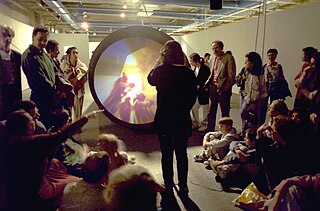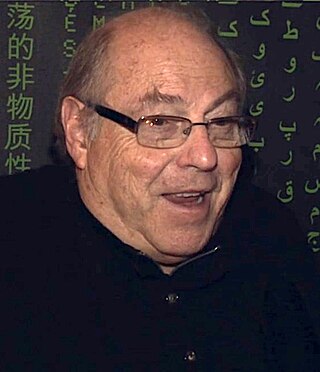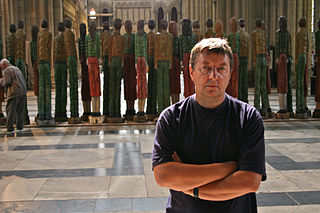
Interactive art is a form of art that involves the spectator in a way that allows the art to achieve its purpose. Some interactive art installations achieve this by letting the observer walk through, over or around them; others ask the artist or the spectators to become part of the artwork in some way.

Electronic art is a form of art that makes use of electronic media. More broadly, it refers to technology and/or electronic media. It is related to information art, new media art, video art, digital art, interactive art, internet art, and electronic music. It is considered an outgrowth of conceptual art and systems art.
Information art, which is also known as informatism or data art, is an emerging art form that is inspired by and principally incorporates data, computer science, information technology, artificial intelligence, and related data-driven fields. The information revolution has resulted in over-abundant data that are critical in a wide range of areas, from the Internet to healthcare systems. Related to conceptual art, electronic art and new media art, informatism considers this new technological, economical, and cultural paradigm shift, such that artworks may provide social commentaries, synthesize multiple disciplines, and develop new aesthetics. Realization of information art often take, although not necessarily, interdisciplinary and multidisciplinary approaches incorporating visual, audio, data analysis, performance, and others. Furthermore, physical and virtual installations involving informatism often provide human-computer interaction that generate artistic contents based on the processing of large amounts of data.

Chelsea College of Arts is a constituent college of the University of the Arts London based in London, United Kingdom, and is a leading British art and design institution with an international reputation.

The UCL Slade School of Fine Art is the art school of University College London (UCL) and is based in London, England. It has been ranked as the UK's top art and design educational institution. The school is organised as a department of UCL's Faculty of Arts and Humanities.
Eugene "Gene" Martynec is a Canadian musician, composer and record producer.

Roy Ascott FRSA is a British artist, who works with cybernetics and telematics on an art he calls technoetics by focusing on the impact of digital and telecommunications networks on consciousness. Since the 1960s, Ascott has been a practitioner of interactive computer art, electronic art, cybernetic art and telematic art.
Susan Alexis Collins is a British artist and academic. She is currently Slade Professor and Director of the Slade School of Fine Art in London, England.
The Lansdown Centre for Electronic Arts was a research centre at Middlesex University in North London, England. It played a significant role in the early development of computer graphics and continued to innovate in interactive media, sonic arts and moving image. It also provided postgraduate and undergraduate teaching.
The Computer Arts Society (CAS) was founded in 1968, in order to encourage the creative use of computers in the arts.
The London Centre for Arts and Cultural Exchange (LCACE) is a university initiative promoting the exchange of knowledge and expertise with the capital's arts and cultural sectors. The initiative was formed in 2004 to encourage collaboration between its partner universities and London's arts and cultural sectors. LCACE was initially funded from the Higher Education Funding Council of England's HEIF 2 Fund. The initiative is based at Somerset House and aims to produce networking and information-based events to highlight formal Knowledge transfer initiatives such as those supported by the Arts and Humanities Research Council.
Iniva is the Institute of International Visual Art, a visual arts organisation based in London that collaborates with contemporary artists, curators and writers. Iniva runs the Stuart Hall Library, and is based in Pimlico, on the campus of Chelsea College of Arts.

Rivington Place is a purpose-built international visual arts centre in Shoreditch, London.

CyberArts International was a series of conferences dealing with emerging technologies that took place during years 1990, 1991, and 1992 in Los Angeles and Pasadena, California. The gatherings brought together artists and developers in all types of new media, including software engineers, electronic musicians, and graphic artists to explore what was a new field at the time, digital media collaborations.
Andrew Michael Stahl is a British painter who lives and works in the United Kingdom (UK). Known for his large figurative paintings, he is a Professor of Fine Art and Head of Undergraduate Painting at the Slade School of Fine Art.

Robert Koenig is an English sculptor, who specialises in wood sculpture and is a prominent exponent of the art of woodcarving using the traditional tools of mallet and chisel. He is known for his carved and polychromed figurative wood sculptures, which he has been creating since the early 1980s. One of the earliest polychromed figures was shown in the 'Temple' exhibition at the Shaw Theatre, London in 1988.

New media art includes artworks designed and produced by means of electronic media technologies, comprising virtual art, computer graphics, computer animation, digital art, interactive art, sound art, Internet art, video games, robotics, 3D printing, and cyborg art. The term defines itself by the thereby created artwork, which differentiates itself from that deriving from conventional visual arts. New Media art has origins in the worlds of science, art, and performance. Some common themes found in new media art include databases, political and social activism, Afrofuturism, feminism, and identity, a ubiquitous theme found throughout is the incorporation of new technology into the work. The emphasis on medium is a defining feature of much contemporary art and many art schools and major universities now offer majors in "New Genres" or "New Media" and a growing number of graduate programs have emerged internationally. New media art may involve degrees of interaction between artwork and observer or between the artist and the public, as is the case in performance art. Yet, as several theorists and curators have noted, such forms of interaction, social exchange, participation, and transformation do not distinguish new media art but rather serve as a common ground that has parallels in other strands of contemporary art practice. Such insights emphasize the forms of cultural practice that arise concurrently with emerging technological platforms, and question the focus on technological media per se. New Media art involves complex curation and preservation practices that make collecting, installing, and exhibiting the works harder than most other mediums. Many cultural centers and museums have been established to cater to the advanced needs of new media art.
Kathy Rae Huffman is an U.S American curator, writer, producer, researcher, lecturer and expert for video and media art. Since the early 1980s, Huffman is said to have helped establish video and new media art, online and interactive art, installation and performance art in the visual arts world. She has curated, written about, and coordinated events for numerous international art institutes, consulted and juried for festivals and alternative arts organisations. Huffman not only introduced video and digital computer art to museum exhibitions, she also pioneered tirelessly to bring television channels and video artists together, in order to show video artworks on TV. From the early 1990s until 2014, Huffman was based in Europe, and embraced early net art and interactive online environments, a curatorial practice that continues. In 1997, she co-founded the Faces mailing list and online community for women working with art, gender and technology. Till today, Huffman is working in the US, in Canada and in Europe.
The Walking Artists Network (WAN) is an international network dedicated to walking as a critical and artistic practice; it reflects the growth and increased interest in walking art. It is based at the University of East London's Centre for Performing Arts Development and contains a network of over 600 members from across the globe, though predominantly based in the United Kingdom. The network maintains an active email discussion community through JISCmail.
Barbara Sykes into a family of artists, designers and inventors. Since childhood, she has produced work in a variety of different art forms. In 1974, she became one of Chicago’s pioneering video and new media artists and, later to include, independent video producer, exhibition curator and teacher. Sykes is a Chicago based experimental video artist who explores themes of spirituality, ritual and indigeneity from a feminist perspective. Sykes is known for her pioneering experimentation with computer graphics in her video work, utilizing the Electronic Visualization Laboratory at the University of Illinois, Chicago, at a time when this technology was just emerging. Her early works broke new grounds in Chicago’s emerging New Media Art scene, and continue to inspire women to explore experimental realms. With a passion for community, she fostered significant collaborations with many institutions that include but are not limited to University of Illinois, School of the Art Institute of Chicago, Columbia College, Center for New Television, and (art)n laboratory. These collaborations became exemplary for the showcasing of new media work. The wave of video, new media and computer art that she pioneered alongside many other seminal early Chicago New Media artists persists as a major influence for artists and educators today. Her work has been exhibited internationally, at institutions such as Moderna Museet (Stockholm), Ny Carlsberg Glyptotek (Copenhagen), Musée d'Art Moderne de la Ville de Paris, Museum of Contemporary Art San Diego, Metropolitan Museum of Art , Museum of the Art Institute (Chicago), The Metropolitan Museum of Art and SIGGRAPH. Sykes’s tapes have been broadcast in Sweden, Italy, Puerto Rico and extensively throughout in the US, including “The Independents,” PBS national broadcast, 1985, and national cablecast, 1984. Media Burn has a selection of her tapes online and over 200 of her raw footage, master edits, dubs and compilation tapes in their archives. Select grants include a National Endowment for the Arts and American Film Institute Regional Fellowship, Evanston Art Council Cultural Arts Fund and several Illinois Arts Council grants. In 2017, Sykes began to paint. In 2020, as the recipient of an Evanston Art Center Individual Artist Exhibition Award, Ethereal Abstractions, Sykes’s first solo watercolor exhibition premiered 81paintings and she gave an online Artist Talk. Her paintings are lyrical, colorful abstractions reminiscent of organic shapes, ethereal forms and underwater landscapes - evocative impressions of spiritual and elemental worlds. They evoke the spontaneity and themes that have evolved from her previous body of time-based and digital artwork. In 2021, she moved to Florida. Her 2022 painting exhibitions/reviews include Forces of Nature showcased on the cover of Estero Life Magazine and she is in the article, Beholding Beauty: Artists of Estero Exhibit at COCO Art Gallery, the Florida Watercolor Society’s 2022 Online Show, the 36th Annual All Florida Exhibition and Connections Art in Flight exhibit at the Southwest Florida International Airport, June 2022 to June 2023. She paints under the name of Barbara L. Sykes.








